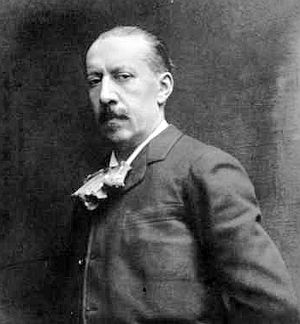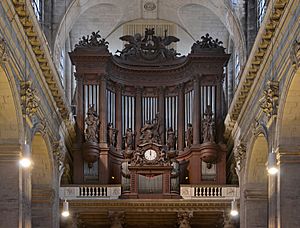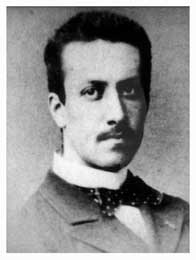Charles-Marie Widor facts for kids
Quick facts for kids
Charles-Marie Widor
|
|
|---|---|

Widor, c. 1900
|
|
| Born |
Charles-Marie-Jean-Albert Widor
21 February 1844 Lyon, France
|
| Died | 12 March 1937 (aged 93) Paris, France
|
| Nationality | French |
| Occupation | composer, organist |
Charles-Marie Widor (born February 21, 1844 – died March 12, 1937) was a famous French organist, composer, and teacher. He is best known for his ten amazing pieces called organ symphonies. His "Toccata" from the Fifth Organ Symphony is one of the most popular and often played organ songs ever!
Widor was the longest-serving organist at Saint-Sulpice church in Paris. He played there for 63 years, from 1870 to 1933. He also taught music at the famous Paris Conservatory. First, he taught organ, and later, he taught how to compose music.
Widor wrote a lot of music for different instruments, like the organ, piano, and voice. He also wrote operas (musical plays) and a ballet (a dance story). He was one of the first composers to call his organ pieces "symphonies." This was because of the new, powerful organs built by Aristide Cavaillé-Coll, which sounded like a whole orchestra!
Contents
Widor's Early Life and Career
Charles-Marie Widor was born in Lyon, France. His family built organs, so he grew up around music. He first learned music from his father, who was also an organist.
A family friend, Aristide Cavaillé-Coll, was a very famous organ builder. He helped young Widor go to Brussels to study music. Widor learned how to play the organ from Jacques-Nicolas Lemmens. He also learned how to compose music from François-Joseph Fétis.
After his studies, Widor moved to Paris. When he was 24, he became an assistant organist at a church called Église de la Madeleine.
Becoming a Famous Organist

In 1870, when Widor was just 25, he got a very important job. He became the "provisional" (temporary) organist at Saint-Sulpice church in Paris. This church had an amazing organ built by his friend Cavaillé-Coll. This organ was so grand that it inspired Widor to write many of his famous pieces.
Even though his job was called "provisional," Widor stayed at Saint-Sulpice for almost 64 years! He finally retired in 1933. His student, Marcel Dupré, took over his job.
Teaching and Students
In 1890, Widor became an organ professor at the Paris Conservatory. He took over from another famous composer, César Franck. Widor expected his students to be very skilled and know a lot about the music of Johann Sebastian Bach.
Later, in 1896, he became a composition professor at the same school. Many of his students became famous musicians themselves. Some of them include Marcel Dupré, Louis Vierne, Darius Milhaud, and Edgard Varèse.
Widor also worked with Albert Schweitzer, a famous doctor and musician. They worked together to publish Bach's organ music.
Travels and Honors
Widor was a well-known organ player and traveled to many countries. He played concerts in Russia, England, Germany, and more. He also played at the opening concerts for many of Cavaillé-Coll's biggest organs, like the one at Notre-Dame de Paris.
People respected Widor for his knowledge and culture. He received many important awards, including the highest French honor, the Légion d'honneur. He was also chosen to be a member of the Institut de France, a group of France's most important people in arts and sciences.
In 1921, Widor helped start the American Conservatory in Fontainebleau, France. He was the director there for many years.
Widor married Mathilde de Montesquiou-Fézensac when he was 76 years old. He retired from Saint-Sulpice at age 89. He passed away in Paris in 1937, at 93 years old.
Widor's Organ Symphonies
Widor wrote music for many different instruments, including four operas and a ballet. However, his most famous works today are his pieces for the organ, especially his ten organ symphonies.
It's unusual to call a piece for a single instrument a "symphony." But Widor was part of a movement that used new organ designs. These organs, built by Aristide Cavaillé-Coll, were very powerful and could sound like a full orchestra. They had many different sounds (called "stops") and could play very loud or very soft. This new type of organ encouraged composers like Widor to write music that was grand and symphonic.
Widor's symphonies can be grouped into three parts:
- The first four symphonies (Op. 13, from 1872) were more like "suites" or collections of pieces. Widor later changed some of these.
- The next four symphonies (Op. 42, from 1879 and 1887) show Widor's great skill. He used all the amazing features of the Cavaillé-Coll organs.
- The Fifth Symphony has five parts, and the last part is the famous "Toccata."
- The Sixth Symphony is also well-known for its first movement.
- The last two symphonies, "Gothique" (Op. 70, 1895) and "Romane" (Op. 73, 1900), are more thoughtful. They use old church melodies (called plainchant) as their themes. The "Andante sostenuto" from the "Symphonie Gothique" is one of Widor's most loved pieces.
The Famous Toccata
Widor's most famous piece for the organ is the final movement of his Symphony for Organ No. 5. This piece is a fast, showy work called a toccata. It is often played at weddings and at the end of Christmas Midnight Mass at Saint Peter's Basilica in Vatican City.
This "Toccata" was the first of its kind in French Romantic organ music. It inspired many other composers to write similar pieces. Widor was happy that his "Toccata" was so famous, but he often thought other organists played it too fast. He preferred a slower, more controlled speed. He even recorded the piece himself when he was 89 years old, and his version is quite slow.
Widor often went back to his earlier music and changed it, even after it was published. He made many different versions of his symphonies over the years.
Widor's Compositions
Here are some of the types of music Charles-Marie Widor wrote:
Orchestral Works
Widor wrote pieces for a full orchestra, sometimes with a solo instrument like a piano or organ.
| Composition | Year | Instruments |
|---|---|---|
| Ouverture portugaise | 1865 | organ, wind instruments, and orchestra |
| Symphony No. 1, Op. 16 | 1870 | orchestra |
| Piano Concerto No. 1, Op. 39 | 1876 | piano and orchestra |
| Cello Concerto, Op. 41 | 1882 | cello and orchestra |
| Symphony for organ and orchestra, Op. 42 | 1882 | organ and orchestra |
| Symphony No. 2, Op. 54 | 1882 | orchestra |
| Fantaisie, Op. 62 | 1889 | piano and orchestra |
| Symphony No. 3, Op. 69 | 1894 | organ and orchestra |
| Piano Concerto No. 2, Op. 77 | 1906 | piano and orchestra |
| Sinfonia sacra, Op. 81 | 1908 | organ and orchestra |
Organ Solo Works
These are the famous pieces Widor wrote just for the organ.
| Composition | Year |
|---|---|
| Symphonie pour orgue No. 1, Op. 13 No. 1 | 1872 (revised many times) |
| Symphonie pour orgue No. 2, Op. 13 No. 2 | 1872 (revised 1901) |
| Symphonie pour orgue No. 3, Op. 13 No. 3 | 1872 (revised many times) |
| Symphonie pour orgue No. 4, Op. 13 No. 4 | 1872 (revised many times) |
| Symphonie pour orgue No. 5, Op. 42 No. 1 | 1879 (revised many times) |
| Symphonie pour orgue No. 6, Op. 42 No. 2 | 1879 |
| Symphonie pour orgue No. 7, Op. 42 No. 3 | 1887 (revised many times) |
| Symphonie pour orgue No. 8, Op. 42 No. 4 | 1887 |
| Symphonie gothique pour orgue [No. 9], Op. 70 | 1895 |
| Symphonie romane pour orgue [No. 10], Op. 73 | 1900 |
| Suite latine, Op. 86 | 1927 |
| Trois Nouvelles pièces, Op. 87 | 1934 |
Chamber Music
These are pieces for a small group of instruments.
| Composition | Year | Instruments |
|---|---|---|
| 6 duos, Op. 3 | 1867 | piano and harmonium |
| Piano Quintet No. 1, Op. 7 | 1868 | piano |
| Sérénade, Op. 10 | 1870 | flute, violin, cello, piano, and harmonium |
| Piano Trio, Op. 19 | 1875 | piano |
| 3 Pièces, Op. 21 | 1875 | cello and piano |
| Suite, Op. 34 | 1877; 1898 | flute and piano |
| Piano Quartet, Op. 66 | 1891 | piano |
| Introduction et rondo, Op. 72 | 1898 | clarinet and piano |
| Salvum fac populum tuum, Op. 84 | 1916 | 3 trumpets, 3 trombones, drum, and organ |
Piano Solo Works
Pieces written just for the piano.
| Composition | Year |
|---|---|
| Variations de concert sur un thème original, Op. 1 | 1867 |
| Airs de ballet, Op. 4 | 1868 |
| Scherzo-valse, Op. 5 | 1868 |
| Caprice, Op. 9 | 1868 |
| 12 Feuillets d'album, Op. 31 | 1877 |
| Carnaval, 12 pièces, Op. 61 | 1889 |
Songs and Choral Works
Music for voices, sometimes with instruments.
| Composition | Year | Instruments |
|---|---|---|
| O Salutaris, Op. 8 | 1868 | contralto or baritone, violin, cello, and organ |
| 6 Mélodies, Op. 14 | 1872 | voice and piano |
| Messe, Op. 36 | 1878 | baritone chorus, mixed chorus, and two organs |
| Ave Maria, Op. 59 | 1884 | voice, harp, and organ |
| Soirs d'été, Op. 63 | 1889 | voice and piano |
| Psalm 112 | 1879 | baritone, chorus, organ, and orchestra |
Stage Music
Music written for plays, ballets, or operas.
| Composition | Year | Stage Music Type |
|---|---|---|
| La Korrigane | 1880 | ballet |
| Maître Ambros, Op. 56 | 1886 | opera |
| Conte d'avril, Op. 64 | 1885; 1891 | incidental music (music for a play) |
| Les Pêcheurs de Saint-Jean | 1895; 1904 | opera |
| Nerto | 1924 | opera |
Writings by Widor
Widor also wrote books about music:
- Technique of the Modern Orchestra (1904)
- The Modern Organ (1928)
- Old Songs for Little Children (with music arrangements)
| Preceded by Louis James Alfred Lefébure-Wély |
Titular Organist, Saint Sulpice Paris 1870–1934 |
Succeeded by Marcel Dupré |
See also
 In Spanish: Charles-Marie Widor para niños
In Spanish: Charles-Marie Widor para niños


